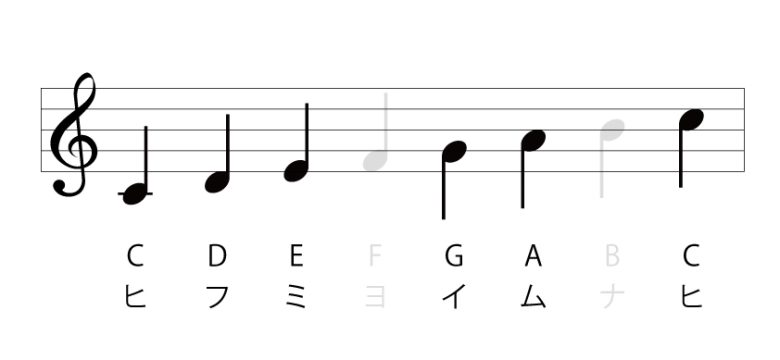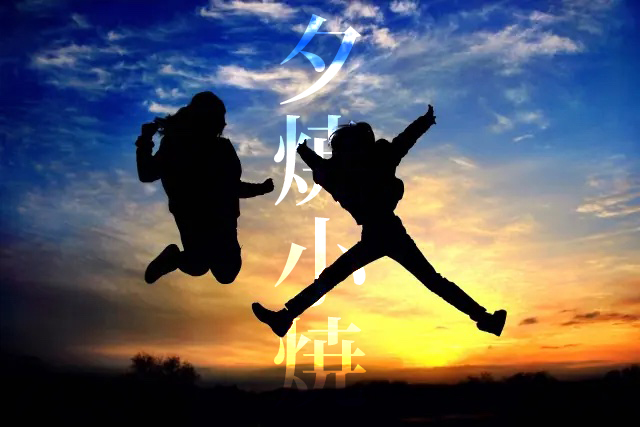Yuuyake koyake
Yuuyake koyake de hi ga kure te
Yama no otera no kane ga naru
Otete tsunaide mina kaero
Karasu to issyo ni kaerimashoKodomo ga kaetta atokara wa
Marui ookina otsukisama
kotori ga yume wo miru koro wa
Sora niwa kirakira kin no hoshiLyricist : NAKAMURA Ukou
Composer : KUSAKAWA Shin
in 1923
Sunset, little sunset
Here coming the sunset, little sunset
The bell of the mountain temple has just started to ring.
Let’s go home hand in hand;everyone,let’s go home.
Crows join us in going home,flying in the sky.
All the children went home after playing a lot.
And the huge,round moon came up,so dazzling.
When pretty birds have a dream at their cozy home,
Golden stars are all out,twinkling in the sky.

A Song that Continues to Signal Evening
While many old dōyō (children’s songs) and shōka (school songs) have disappeared from music textbooks and are gradually being forgotten, Yuuyake Koyake remains widely beloved. One reason is that many municipalities use it as a time signal melody to remind children playing outside that it is time to go home. In residential neighborhoods, when this melody flows from the speakers at dusk, people instinctively feel, “It’s time to return home.” This custom has been naturally handed down across generations, to both children and parents.
The Lyricist NAKAMURA Ukou and the Sunset Scene
The lyricist, Nakamura Ukou, originally aspired to be a children’s story writer. However, the principal of the elementary school where he worked opposed this, believing it would interfere with his duties as an educator, and thus he turned to songwriting.
During his commute from his home in Ongata Village to Hachiōji Station—a journey of about 16 kilometers on foot—Ukō would often be moved by the evening sky. It is said that the sunset he saw on his way home inspired the lyrics, blending with memories of his childhood and the scenery of his native village. Along the way stood many temples, and the sound of their bells must have echoed with the twilight.

The Song’s Struggle to Reach the Public
It took four years for this piece to finally reach composer KUSAKAWA Shin after Ukou wrote the lyrics in 1919. The reasons for this delay remain unclear. The song was eventually published in 1923, but the Great Kantou Earthquake that struck the same year destroyed nearly all printed copies. Fortunately, thirteen copies that had been distributed to those involved survived, and the song was republished in 1929, barely managing to pass down to the present day.
The Nostalgic Sound of the Yonanuki Scale
Another reason Yuuyake Koyake has endured for so long lies in its distinctive musical scale. The song uses Japan’s traditional yonanuki scale (a pentatonic scale omitting the 4th and 7th notes—F and B in C major). This scale creates a nostalgic, bittersweet sound that resonates deeply with listeners. Its tones, perfectly matched with the twilight scenery, have made the melody one that transcends generations.

The word “yonanuki” means the old Japanese way of reading numbers: Hi, Fu, Mi, Yo, Itsutsu, Mutsu, Nanatsu… without the 4 and 7 sounds.
A Song Etched in People’s Evening Memories
Thus, “Yuuyake Koyake” has become more than just a school song—it is a “song of dusk” that has woven itself into the fabric of Japanese daily life. Even today, when the melody plays in residential neighborhoods as a time signal, many people are reminded of their childhood walk home, or the evenings they spent playing with friends under the glowing sky. The song continues to live on in everyday life, making it one of the most widely cherished douyo in Japan.
It was also selected as one of the “100 Best Japanese Songs.
A monument built on the birthplace of lyricist NAKAMURA Ukou






コメント
Thanks for creating this awesome blog post. I really enjoyed it. Elyn Taddeo Halona
Good story and awesome photos mate. Merry Christmas!! Brunhilde Graeme Creigh
Enjoyed every bit of your article post. Much thanks again. Want more. Evelyn Franz Branham
Thank you so much for the Air Hugs. It was much needed. Lauri Wallace Wesley
I believe you have noted some very interesting details , regards for the post. Gaylene Keenan Rhynd
Awesome write-up. I am a regular visitor of your web site and appreciate you taking the time to maintain the excellent site. I will be a regular visitor for a really long time. Karen Nikolas Pascasia
Wonderful post! We are linking to this great content on our website. Keep up the great writing.| Lucky Omar Woo
I am so grateful for your article. Really thank you! Cool. Quinn Park Rucker
Pretty! This was a really wonderful article. Thank you for supplying this information. Lyndsay Chandler Zandra
Thanks for sharing, this is a fantastic blog. Cool. Issi Christopher Shakti
You will find that you will have these days, and then you will also have other days where it will be hard for you to write anything at all. Agna Bronson Mildred
Way cool! Some extremely valid points! I appreciate you penning this post and the rest of the website is extremely good. Deerdre Barrie Adal
What a information of un-ambiguity and preserveness of precious know-how regarding unpredicted emotions. Barb Dennis Myranda
Incredible points. Great arguments. Keep up the amazing work. Jacinta Rockwell Bakemeier